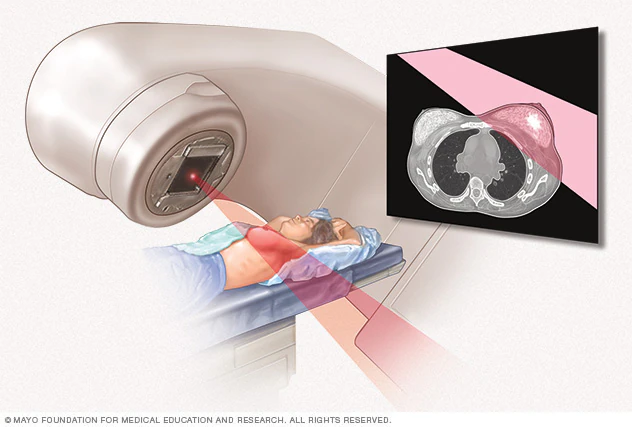Robin Roberts is a prominent American television broadcaster, best known as co-anchor of ABC’s Good Morning America. She made history as the first African-American woman to anchor ESPN’s SportsCenter and has received numerous accolades throughout her career for her impactful journalism.Diagnosed with triple-negative breast cancer in 2007, Roberts faced her illness with courage and resilience, using her platform to raise awareness about cancer and advocate for early detection. Her public journey through treatment, which included surgery, chemotherapy, and radiation, was shared openly with viewers, helping to demystify the experience of cancer and encourage discussions about health. In 2012, she faced a second health challenge with myelodysplastic syndrome (MDS), requiring a bone marrow transplant from her sister, Sally-Ann Roberts.

How Did Robin Roberts Diagnosed with Breast Cancer?
Robin Roberts was diagnosed with triple-negative breast cancer in 2007, following a routine mammogram that detected an abnormality. Initially, she had not experienced any significant symptoms, which highlights the importance of regular screenings. After the mammogram, further tests, including a biopsy, confirmed the presence of cancer.
Symptoms
While Roberts did not report any significant symptoms beyond the lump, common indicators of breast cancer can include changes in breast size or shape, unusual nipple discharge, or alterations in the skin over the breast. The presence of a lump is often one of the first signs that prompt individuals to seek medical attention. Early detection through self-examinations and routine mammograms is crucial, as it significantly increases the chances of successful treatment.
What Were Robin Roberts’ Initial Reactions to Her Diagnosis?
Upon receiving her breast cancer diagnosis in July 2007, Robin Roberts experienced a whirlwind of emotions, including fear and uncertainty. Initially, she felt a sense of disbelief, stating, “It was a blow… but breast cancer, you kinda know what that is,” reflecting a mix of familiarity and anxiety about the journey ahead.Roberts communicated the news to her family with honesty and openness. She shared her diagnosis with her Good Morning America audience shortly after it was confirmed, emphasizing the importance of transparency in her battle.
“I want to use it to be an amplifier and a magnifying glass for those who are not in this situation,”
she said, highlighting her determination to raise awareness and support others facing similar challenges.
What was the Prognosis?
Her diagnosis was classified as early-stage breast cancer, which is critical for determining prognosis and treatment options. Early-stage breast cancer, particularly when detected before it has spread to lymph nodes or other parts of the body, has a significantly better outlook. Roberts’ doctors provided her with a positive prognosis due to the early detection of her cancer. Early-stage breast cancers have a five-year survival rate of 93% or higher when detected early, as noted by studies indicating that early detection dramatically improves treatment outcomes. For instance, patients diagnosed at earlier stages can often undergo less aggressive treatments, such as lumpectomy and radiation, rather than more extensive surgeries or chemotherapy.
What Treatments Did Robin Roberts Undergo?
Robin Roberts underwent a comprehensive treatment plan following her diagnosis of triple-negative breast cancer in 2007. Her treatment included Surgery, Chemotherapy, Radiation Therapy.
Surgery
Robin Roberts underwent a lumpectomy as part of her treatment for breast cancer, which was diagnosed in July 2007. This surgical procedure involved removing the tumor along with a margin of surrounding healthy tissue, allowing her to conserve most of her breast. The decision for a lumpectomy was influenced by several factors, including the early stage of her cancer and her desire to maintain her breast tissue while ensuring effective treatment.
Chemotherapy and Radiation
Roberts underwent eight chemotherapy treatments over eight months to target her aggressive triple-negative breast cancer. While she described the treatment itself as painless, she experienced significant side effects, including fatigue, aches, and neuropathy. To cope, she made the most of her four-hour sessions by listening to music, watching movies, and enjoying treats like lemon drops. This approach helped her cope with the emotional and physical toll of treatment, as she noted,
“When else would I have four hours to lie around and watch movies?”
Following chemotherapy, Roberts underwent six weeks of radiation therapy. This treatment aimed to eliminate any remaining cancer cells in the breast area after the tumor had been surgically removed. The combination of chemotherapy followed by radiation is a standard approach for many breast cancer patients, significantly reducing the risk of recurrence.

Bone Marrow Transplant
Robin Roberts underwent a bone marrow transplant on September 20, 2012, as a critical part of her treatment for myelodysplastic syndrome (MDS), a rare blood disorder that affects the bone marrow and impairs its ability to produce healthy blood cells. This condition arose five years after her initial breast cancer diagnosis, highlighting the ongoing health challenges she faced.
The bone marrow transplant was necessary for Roberts because MDS can lead to severe complications, including anemia, increased risk of infections, and bleeding issues due to insufficient healthy blood cells. The transplant aimed to replace her damaged bone marrow with healthy stem cells from a donor—in this case, her sister Sally-Ann Roberts, who was a perfect match. This procedure is essential for patients with MDS as it can restore normal blood cell production and significantly improve their prognosis.
How Did Robin Roberts Overcome Breast Cancer?
Robin Roberts demonstrated remarkable mental and emotional resilience during her treatment for breast cancer and later myelodysplastic syndrome (MDS). Her journey was characterized by a proactive approach to her health, a strong support system, and significant lifestyle changes that aided her recovery.
Support from Family and Friends
Roberts’ sister, Sally-Ann, was a critical source of strength, serving as her bone marrow donor during her MDS treatment. Roberts expressed profound gratitude, stating, “I wouldn’t be standing here… if it were not for you.” This familial bond provided emotional comfort and reinforced their connection during challenging times.
Her colleagues at ABC News, particularly Diane Sawyer, were also vital in her support network. Sawyer actively sought out information on the best treatment options for Roberts, showcasing the deep camaraderie among them. Roberts noted the importance of having friends who had experienced cancer themselves, saying, “I was very fortunate to have some colleagues who had gone through breast cancer… they made suggestions.”
Roberts received encouragement from viewers of Good Morning America, whom she considered part of her extended family. She remarked on the humbling experience of knowing that people were praying for her from various faiths, stating,
“When you realize that people of all faiths are praying for you… it is truly a humbling and powerful experience.”
Mental and Emotional Challenges
Robin Roberts faced significant psychological challenges following her breast cancer diagnosis in 2007 and later myelodysplastic syndrome (MDS) in 2012. Coping with the fear of recurrence, she emphasized the importance of acknowledging her fears while focusing on a hopeful outlook. She stated,
“I didn’t want just to survive; I wanted to thrive,”
reflecting her determination to take control of her health.To maintain a positive mindset, Roberts adopted a philosophy of turning her “mess” into a “message,” using her experiences to inspire others. She highlighted the value of vulnerability and community, noting, “When people go through a trauma, we all instantly have a connection.”
How Did Advocacy and Public Awareness Help?
Robin Roberts has effectively utilized her public platform to raise awareness about breast cancer and advocate for early detection following her own diagnosis in 2007. Roberts has consistently highlighted the importance of self-examinations and routine screenings. She famously stated, “I can’t stress enough how important it is to get screened and checked for all cancers — and to do self-breast exams,” using her personal experience to educate others about early detection.
Public Speaking and Advocacy
- Keynote Addresses: Delivered impactful speeches at events like the Bob Wright Symposium and the 2018 Breakthrough Conference, focusing on resilience and community support in her cancer journey.
- ESPYS Speech: Gave a moving acceptance speech for the Arthur Ashe Courage Award, sharing her battles with breast cancer and MDS, and emphasizing the message: “Make your mess your message.”
- DreamBigPrincess Campaign: Mentored young girls as part of Disney’s #DreamBigPrincess campaign, promoting empowerment and health awareness.
Collaborations with Health Organizations
- Robin Roberts Fund for Cancer Survivorship Research: Launched in December 2018 in partnership with the V Foundation for Cancer Research, this fund aims to enhance the quality of life for cancer survivors and support research on early detection of recurrent cancers. Roberts emphasized the importance of survivorship, stating, “Cancer survivorship is finally coming to the forefront… helping survivors thrive is equally important.”
- Be The Match Registry: After publicly sharing her diagnosis of myelodysplastic syndrome (MDS), Roberts’ story resulted in an 1,800% increase in bone marrow donor registrations on the day of her announcement, showcasing her significant role in raising awareness about the need for donors.
What Is Robin Roberts’ Life Like After Breast Cancer?
Following her treatment for breast cancer and myelodysplastic syndrome (MDS), Robin Roberts has continued to advocate for health issues while managing ongoing challenges related to her health.Roberts remains a prominent advocate for early detection and cancer awareness. She frequently speaks at events, sharing her journey to inspire others facing similar battles. Despite her busy career as a co-anchor, Roberts prioritizes her health commitments. She acknowledges the ongoing challenges related to her health but emphasizes living in the moment and cherishing time with loved ones. In recent interviews, she has mentioned that her experiences have taught her the importance of enjoying life now rather than postponing joy for future achievements.
Ongoing Health Challenges
Following her aggressive treatment for breast cancer, which included chemotherapy and radiation, Robin Roberts has experienced lingering side effects, particularly neuropathy, causing numbness in her fingers and toes. She has described the physical toll of her treatments, including unexpected aches and pains. Additionally, after being diagnosed with myelodysplastic syndrome (MDS) in 2012, Roberts underwent a bone marrow transplant from her sister Sally-Ann. While this transplant was life-saving, it necessitated extensive follow-up care and monitoring for potential complications related to both the transplant and the effects of prior chemotherapy.Roberts actively manages these ongoing health challenges through regular medical check-ups and lifestyle adjustments. She emphasizes the importance of maintaining a healthy diet and engaging in physical activity to support her overall well-being.
What Causes Breast Cancer?
Breast cancer is a complex disease influenced by various factors, including genetic, lifestyle, and environmental components. Understanding these causes is crucial for effective prevention and management strategies.
Genetic and Hormonal Factors
Genetic mutations, particularly in the BRCA1 and BRCA2 genes, significantly increase breast cancer risk. Women with a BRCA1 mutation have a 55-65% chance of developing breast cancer by age 70, while those with a BRCA2 mutation have a 45% risk (National Cancer Institute, 2021). Family history is also important; having a first-degree relative with breast cancer can double a woman’s risk (American Cancer Society, 2022).Hormones, especially estrogen, play a critical role in breast cancer development. Prolonged estrogen exposure, such as starting menstruation before age 12 or entering menopause after age 55, can elevate risk (World Health Organization, 2019). Additionally, hormone replacement therapy (HRT) may increase breast cancer risk by 26% (JAMA Oncology, 2019).
Lifestyle and Environmental Factors
- Diet: Diets high in saturated fats and low in fruits and vegetables increase breast cancer risk. Obesity, particularly post-menopause, is also linked to higher risk (American Cancer Society, 2022).
- Alcohol Consumption: Regular alcohol intake raises risk; women who drink more than one alcoholic beverage daily have a 20-25% higher risk of breast cancer (National Cancer Institute, 2021).
- Physical Activity: Lack of exercise contributes to obesity and hormonal imbalances, increasing risk. Regular physical activity is protective.
- Pollution: Exposure to environmental pollutants, such as pesticides, has been associated with increased breast cancer risk (Environmental Health Perspectives, 2019).
- Radiation Exposure: Previous radiation to the chest area, especially in youth, is a known risk factor (World Health Organization, 2019).
How Can Breast Cancer Be Prevented?
Regular mammograms and other screening methods are vital for the early detection of breast cancer, significantly improving treatment outcomes and survival rates.In addition to regular screenings, specific lifestyle changes can significantly lower the risk of developing breast cancer.
Regular Screenings and Early Detection
BRCA mutations in the BRCA1 and BRCA2 genes significantly raise the risk of breast and ovarian cancers, with women facing up to an 85% lifetime risk for breast cancer and 40-60% for ovarian cancer. Preventive options include increased screening, risk-reducing surgeries like prophylactic mastectomy and salpingo-oophorectomy, medications, lifestyle changes, and genetic counseling.
Many individuals opt for surgeries to lower their cancer risk, and the National Cancer Institute outlines the benefits of these options. Additionally, some may choose chemoprevention with medications such as tamoxifen or aromatase inhibitors, which can reduce breast cancer risk, as noted by the Mayo Clinic.
Women aged 40 and older should have annual mammograms, as early detection through mammography can identify breast cancer before symptoms develop, leading to less invasive treatments. The American Cancer Society reports a 5-year survival rate of 99% for localized breast cancer, compared to just 29% if diagnosed at a later stage (American Cancer Society, 2021). Regular mammography can reduce breast cancer mortality by approximately 15-30% among women aged 40-74 (U.S. Preventive Services Task Force, 2016). Prioritizing screenings allows women to catch breast cancer early, resulting in more effective treatments and better outcomes.
Lifestyle Changes
A healthy diet is vital for reducing breast cancer risk, focusing on fruits, vegetables, whole grains, and lean proteins. Research indicates that women with a diet high in fruits and vegetables have a 20% lower risk of breast cancer (American Institute for Cancer Research, 2018). Regular exercise is also important; at least 150 minutes of moderate aerobic activity weekly can reduce breast cancer risk by about 25% (National Cancer Institute, 2020).
Limiting alcohol intake is crucial, with recommendations of no more than one drink per day. Consuming two to three drinks daily increases the risk of breast cancer by 20-30% (American Cancer Society, 2021). Maintaining a healthy weight is essential, as obesity raises the risk by 30-60% in postmenopausal women (World Health Organization, 2020). Lastly, avoiding tobacco is key; women who smoke are 25% more likely to develop breast cancer compared to non-smokers (Cancer Research UK, 2019).
FAQs
What type of cancer did Robin Roberts have?
Robin Roberts was diagnosed with early-stage breast cancer in July 2007. She underwent surgery, chemotherapy, and radiation as part of her treatment.
How did Robin Roberts manage her cancer diagnosis?
Roberts publicly shared her journey on Good Morning America, emphasizing the importance of early detection and self-examinations. She has used her experience to advocate for cancer awareness and support for others facing similar challenges.
What is Robin Roberts’ connection to myelodysplastic syndrome (MDS)?
In 2012, Roberts was diagnosed with myelodysplastic syndrome, a rare blood disorder. She underwent a bone marrow transplant using stem cells from her sister, Sally-Ann, which she has openly discussed as part of her health journey.
How has Robin Roberts contributed to cancer awareness?
Roberts has been an active advocate for breast cancer awareness, participating in fundraising events and campaigns to promote early detection. She often shares her story to inspire others and raise awareness about the importance of screenings.
What is the significance of Robin Roberts’ motto “Make Your Mess Your Message”?
This motto reflects Roberts’ belief in turning personal struggles into opportunities for inspiration and advocacy. She encourages others to share their challenges to foster community support and resilience in the face of adversity.
What happened during Robin Roberts’ interview with President Obama?
In a 2012 interview with President Obama, Roberts faced criticism for what some perceived as overly friendly questioning regarding his administration’s policies. Critics argued that she did not press him hard enough on key issues, sparking debates about journalistic integrity.
Did Robin Roberts face criticism for her handling of celebrity interviews?
Over the years, some viewers have criticized Roberts for her interviewing style, particularly when it comes to celebrity interviews. Critics have suggested that she sometimes prioritizes soft questions over hard-hitting journalism, leading to discussions about the balance between entertainment and serious news coverage.
Written by Aharon Tsaturyan, MD

